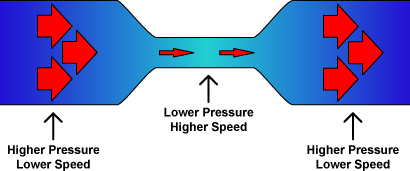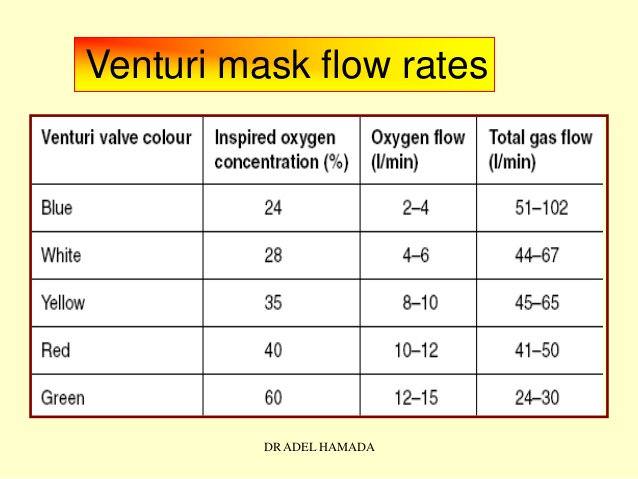Wv: Describe the principles of flow as they relate to the function and classification of oxygen delivery devices
Flow
Flow is the quantity of fluid (gas/liquid) passing a point per unit time
Air flow can be laminar/turbulent depending on Reynold’s number
Normal Peak Inspiratory Flow = 20-30L/min

The amount of O2 you receive from a delivery device depends on your Flow rate & MV
No Device + normal Flow rates
30L/min
FiO2 21%
∴receive 21% O2
30 x 21 = 630%
630/30 = 21% oxygen
Variable Device + Normal Flow rates
10L/min oxygen by face mask (all O2 from wall is 100% O2!)
but normal peak insp flow 30l/min
∴receive
10L/min 100% FiO2
20L/min 21% FiO2
(10×100) + (20×21) = 1420%
1420/30 = 47% oxygen
Variable device + Increased Flow rates
10L/min oxygen by face mask
Increased peak insp flow 50L/min
∴receive
10L/min 100% FiO2
40L/min 21% FiO2
(10×100) + (40×21) = 1840%
1840/50 = 36% oxygen
Fio2 (litre min-1)
1.0
0.6
0.6
0.5
0.5
0.4
0.24
Oxygen flow (driving) (litre min-1)
10
10
20
10
15
10
2
Air flow (entrained) (litre min-1)
0
10
20
17
25
30
38
Total flow (litre min-1)
10
20
40
27
40
40
40
Classification of O2 Delivery Devices
Performance Type
Nasal Prongs
Variable
Hudson Mask
Variable
NRB Mask
Variable
Venturi Mask
Fixed
O2 Flow
Nasal Prongs
1-4L/min
Hudson Mask
1-15L/min
NRB Mask
1-15L/min
Venturi Mask
2-15L/min
depends on colour
FiO2 Delivery
Nasal Prongs
21-30%
Hudson Mask
24-60%
NRB Mask
60-100%
Venturi Mask
Fixed: blue 24%, white 28%, yellow 35%, red 40%, green 60%
Rebreathing
Nasal Prongs
No
Hudson Mask
Yes
NRB Mask
No
Venturi Mask
No – unless super high patient flow rates exceed Venturi flow
Mechanism
Nasal Prongs
Nasal prongs inserted into nose
O2 gas flow 1-4L/min
Nasopharynx acts as O2 resevoir
Even if patient breathes through mouth, O2 will be entrained from nasopharynx
Anything higher will cause drying of nasal mucosa – discomfort, epistaxis, impaired mucociliary clearance
Hudson Mask
Mask does not seal on patient’s face
Holes on each side allow air entrainment to meet Peak Insp Flow & vent expired gas
Plastic tubing connects to O2 supply
NRB Mask
Mask with reservoir bag
ONE WAY insp & exp valves
Insp valve over reservoir bag
Exp valve over side vents
Fill reservoir bag by occluding insp valve
INSPIRATION; insp valve opens and exp valves occluded by negative P
EXPIRATION; positive P occludes insp valve and opens exp valve → Non Reabreather
Venturi Mask
Colour Coded Venturi device
Distal end connects to standard O2 tubing
Proximal end connects to face mask
Oxygen flows through a central constriction on the device, room air is entrained through the apertures due to Venturi effect -> dilutes O2 to deliver what you have preset
Venturi effect due to the Bernoulli Principle
Advantages
Nasal Prongs
Simple & cheap
Patient can speak, eat and drink
Hudson Mask
Simple cheap easy to use
NRB Mask
Great way to deliver high FiO2 if there is an inability to get a seal with BVM
Venturi Mask
Specific and constant O2 concentration delivered
Colour coded for easy application
Disadvantages
Nasal Prongs
Drying of nasal mucosa limits FiO2 unless humidified
Hudson Mask
Precise FiO2 unknown
High risk of rebreathing with increased WoB
NRB Mask
Precise FiO2 unknown
User familiarity – reservoir bag must be blown up
Venturi Mask
Risk of hypoxia by under-delivering O2
Bernoulli Principle
- Total energy of a system is constant
- Total E = Potenial E + Kinetic E
(pressure) (velocity)
- Describes the relationship between velocity and pressure of gas flow
- Gas moves through a constriction in tubing
- Gas velocity increases (Kinetic E)
- Therefore pressure at that point decreases (Potential E)
- Maintains the same amount of Total Energy
- The law of conservation of energy


